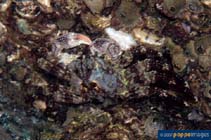Ashtoret lunaris (Forsskål, 1775)
Yellow moon crab| Native range | All suitable habitat | Point map | Year 2050 |

|
| This map was computer-generated and has not yet been reviewed. |
| Ashtoret lunaris AquaMaps Data sources: GBIF OBIS |
Classification / Names Common names | Synonyms | CoL | ITIS | WoRMS
Malacostraca | Decapoda | Matutidae
Environment: milieu / climate zone / depth range / distribution range Ecology
Benthic; depth range 0 - 50 m (Ref. 343). Tropical; 30°N - 38°S, 32°E - 177°W
Distribution Countries | FAO areas | Ecosystems | Occurrences | Introductions
Indo-West Pacific: From East Africa to Philippines, Papua New Guinea and Australia. Tropical to subtropical.
Length at first maturity / Size / Weight / Age
Maturity: Lm 3.3 range ? - ? cm Max length : 6.9 cm CW male/unsexed; (Ref. 119018); 5.9 cm CW (female); max. published weight: 39.90 g (Ref. 119018); max. published weight: 39.90 g
Caught in nets for food. Occurs from intertidal zone to a depth of 50 m. Found on muddy sand or broken shells bottoms (Ref. 106341), and sandy silty shores near seagrass (Ref. 106287).
Life cycle and mating behavior Maturity | Reproduction | Spawning | Eggs | Fecundity | Larvae
Members of the order Decapoda are mostly gonochoric. Mating behavior: Precopulatory courtship ritual is common (through olfactory and tactile cues); usually indirect sperm transfer.
Main reference
References | Coordinator | Collaborators
Hosie, A.M., A. Sampey, P.J. Davie and D.S. Jones. 2015. (Ref. 106854)
IUCN Red List Status (Ref. 130435)
CITES status (Ref. 108899)
Not Evaluated
CMS (Ref. 116361)
Not Evaluated
Threat to humans
Harmless
Human uses
Fisheries: subsistence fisheries
| FishSource |
Tools
More information
Internet sources
BHL | BOLD Systems | CISTI | DiscoverLife | FAO(Publication : search) | Fishipedia | GenBank (genome, nucleotide) | GloBI | Gomexsi | Google Books | Google Scholar | Google | PubMed | Tree of Life | Wikipedia (Go, Search) | Zoological Record
Estimates based on models
Preferred temperature
(Ref. 115969): 24.7 - 29.1, mean 28 (based on 1156 cells).
Price category
(Ref. 80766):
Unknown.



